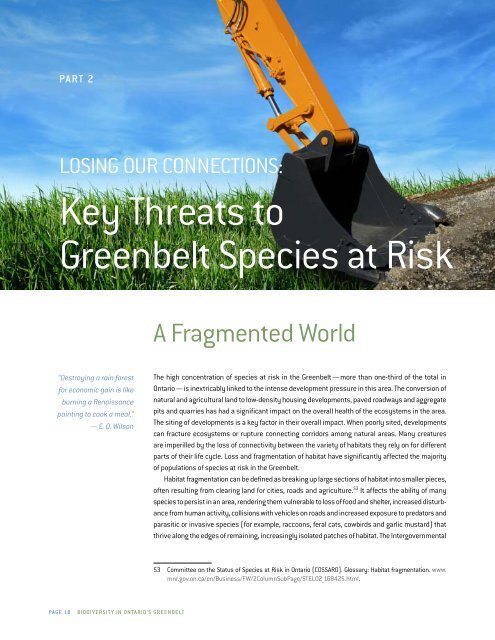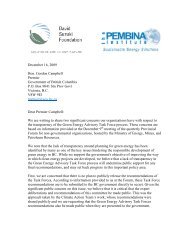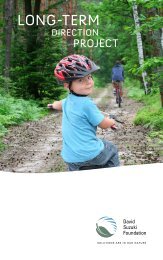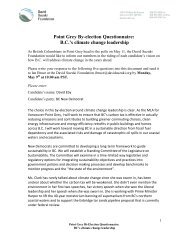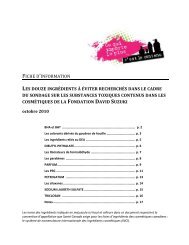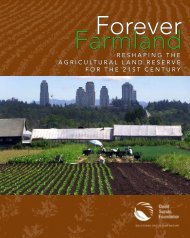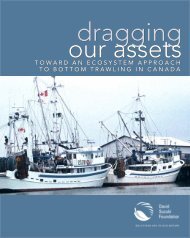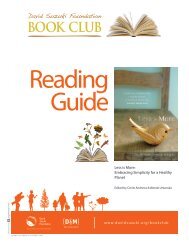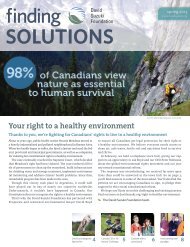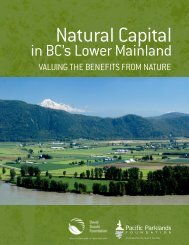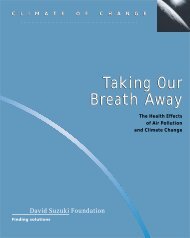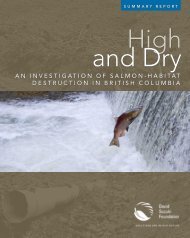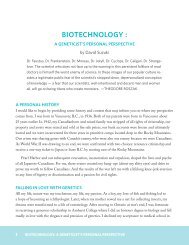Biodiversity in Ontario's Greenbelt (PDF) - David Suzuki Foundation
Biodiversity in Ontario's Greenbelt (PDF) - David Suzuki Foundation
Biodiversity in Ontario's Greenbelt (PDF) - David Suzuki Foundation
Create successful ePaper yourself
Turn your PDF publications into a flip-book with our unique Google optimized e-Paper software.
Part 2<br />
Los<strong>in</strong>g Our Connections:<br />
Key Threats to<br />
<strong>Greenbelt</strong> Species at Risk<br />
A Fragmented World<br />
“Destroy<strong>in</strong>g a ra<strong>in</strong> forest<br />
for economic ga<strong>in</strong> is like<br />
burn<strong>in</strong>g a Renaissance<br />
pa<strong>in</strong>t<strong>in</strong>g to cook a meal.”<br />
— E. O. Wilson<br />
The high concentration of species at risk <strong>in</strong> the <strong>Greenbelt</strong> — more than one-third of the total <strong>in</strong><br />
Ontario — is <strong>in</strong>extricably l<strong>in</strong>ked to the <strong>in</strong>tense development pressure <strong>in</strong> this area. The conversion of<br />
natural and agricultural land to low-density hous<strong>in</strong>g developments, paved roadways and aggregate<br />
pits and quarries has had a significant impact on the overall health of the ecosystems <strong>in</strong> the area.<br />
The sit<strong>in</strong>g of developments is a key factor <strong>in</strong> their overall impact. When poorly sited, developments<br />
can fracture ecosystems or rupture connect<strong>in</strong>g corridors among natural areas. Many creatures<br />
are imperilled by the loss of connectivity between the variety of habitats they rely on for different<br />
parts of their life cycle. Loss and fragmentation of habitat have significantly affected the majority<br />
of populations of species at risk <strong>in</strong> the <strong>Greenbelt</strong>.<br />
Habitat fragmentation can be def<strong>in</strong>ed as break<strong>in</strong>g up large sections of habitat <strong>in</strong>to smaller pieces,<br />
often result<strong>in</strong>g from clear<strong>in</strong>g land for cities, roads and agriculture. 53 It affects the ability of many<br />
species to persist <strong>in</strong> an area, render<strong>in</strong>g them vulnerable to loss of food and shelter, <strong>in</strong>creased disturbance<br />
from human activity, collisions with vehicles on roads and <strong>in</strong>creased exposure to predators and<br />
parasitic or <strong>in</strong>vasive species (for example, raccoons, feral cats, cowbirds and garlic mustard) that<br />
thrive along the edges of rema<strong>in</strong><strong>in</strong>g, <strong>in</strong>creas<strong>in</strong>gly isolated patches of habitat. The Intergovernmental<br />
53 Committee on the Status of Species at Risk <strong>in</strong> Ontario (COSSARO). Glossary: Habitat fragmentation. www.<br />
mnr.gov.on.ca/en/Bus<strong>in</strong>ess/FW/2ColumnSubPage/STEL02_168425.html.<br />
Page 18<br />
<strong>Biodiversity</strong> <strong>in</strong> Ontario’s greenbelt


